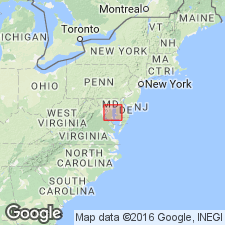
- Usage in publication:
-
- Marlboro clay
- Modifications:
-
- Named
- Dominant lithology:
-
- Clay
- AAPG geologic province:
-
- Atlantic Coast basin
Summary:
Named Marlboro clay for exposures of a red clay bed at the base of the Potapaco member of the Nanjemoy formation near the town of Upper Marlboro, Prince Georges Co., MD. Unit is considered to be of Eocene age.
Source: GNU records (USGS DDS-6; Reston GNULEX).
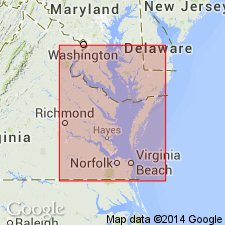
- Usage in publication:
-
- Marlboro clay bed
- Modifications:
-
- Areal extent
- AAPG geologic province:
-
- Atlantic Coast basin
Summary:
Geographically extended the Marlboro clay bed to Virginia. The basal bed of the Nanjemoy formation, known as Marlboro clay, extends from central MD across the Potomac River into VA, and is well developed between Potomac Creek and the Rappahannock River. It consists of 25 feet of compact clay, with the lower part pink and upper part white.
Source: GNU records (USGS DDS-6; Reston GNULEX).
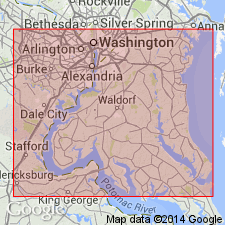
- Usage in publication:
-
- Marlboro clay*
- Modifications:
-
- Revised
- AAPG geologic province:
-
- Atlantic Coast basin
Summary:
Revised Marlboro clay as lower member of Nanjemoy formation. It is 20 or more feet thick and is mostly pink clay consisting of aluminum silicate derived from the crystalline rocks of the Piedmont.
Source: GNU records (USGS DDS-6; Reston GNULEX).
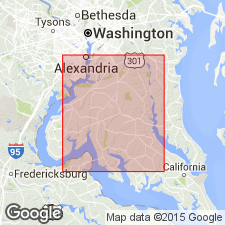
- Usage in publication:
-
- Marlboro Clay*
- Modifications:
-
- Revised
- AAPG geologic province:
-
- Atlantic Coast basin
Summary:
Raised rank of Marlboro Clay to formation. Unit is a silvery-gray to pale-red plastic clay interbedded with much subordinate yellowish-gray to reddish silt. Its thickness ranges from a feather edge to 30 feet with an average of 20 feet. The lower contact of the Marlboro Clay with the underlying Aquia Formation is probably an unconformity. The upper contact with the Nanjemoy Formation is sharp but is disrupted by burrowing.
Source: GNU records (USGS DDS-6; Reston GNULEX).
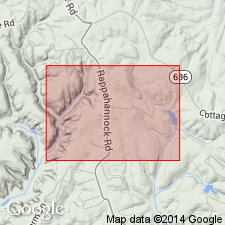
- Usage in publication:
-
- Marlboro Clay*
- Modifications:
-
- Age modified
- Biostratigraphic dating
- AAPG geologic province:
-
- Atlantic Coast basin
Summary:
Pollen and dinoflagellate data indicate a latest Paleocene to earliest Eocene age for the Marlboro Clay.
Source: GNU records (USGS DDS-6; Reston GNULEX).
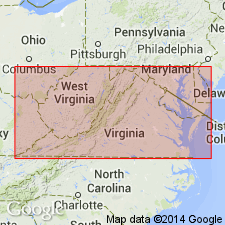
- Usage in publication:
-
- Marlboro Clay*
- Modifications:
-
- Age modified
- Biostratigraphic dating
- AAPG geologic province:
-
- Atlantic Coast basin
Summary:
Calcareous nannofossil data from Maryland and Virginia indicate that the Marlboro Clay is entirely of late Paleocene age. This is in disagreement with pollen data which indicate that the Marlboro spans the Paleocene-Eocene boundary.
Source: GNU records (USGS DDS-6; Reston GNULEX).

- Usage in publication:
-
- Marlboro Clay
- Modifications:
-
- Overview
- AAPG geologic province:
-
- Atlantic Coast basin
Summary:
Undifferentiated Pamunkey Group, Old Church Formation, and unnamed glauconitic sands lumped on State map as lower Tertiary deposits. Individual units discussed in text. Marlboro Clay of Pamunkey Group described as light-gray, pinkish-gray, and reddish-brown kaolinitic clay, massively bedded to laminated, interbedded with lesser amounts of laminated and ripple cross-laminated silt and very fine-grained sand. Contains rare molds of small mollusks and arenaceous foraminifers. Thickness ranges from 0 to 30 ft. Age is late Paleocene and early Eocene(?).
Source: GNU records (USGS DDS-6; Reston GNULEX).
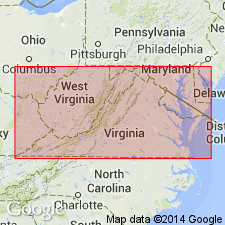
- Usage in publication:
-
- Marlboro Clay*
- Modifications:
-
- Age modified
- AAPG geologic province:
-
- Atlantic Coast basin
Summary:
Age of Marlboro Clay in southeastern VA is Paleocene. [Age is controversial.]
Source: GNU records (USGS DDS-6; Reston GNULEX).
For more information, please contact Nancy Stamm, Geologic Names Committee Secretary.
Asterisk (*) indicates published by U.S. Geological Survey authors.
"No current usage" (†) implies that a name has been abandoned or has fallen into disuse. Former usage and, if known, replacement name given in parentheses ( ).
Slash (/) indicates name conflicts with nomenclatural guidelines (CSN, 1933; ACSN, 1961, 1970; NACSN, 1983, 2005, 2021). May be explained within brackets ([ ]).

